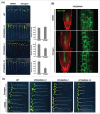VPS36-Mediated plasma membrane protein turnover is critical for Arabidopsis root gravitropism
- PMID: 28340324
- PMCID: PMC5437823
- DOI: 10.1080/15592324.2017.1307495
VPS36-Mediated plasma membrane protein turnover is critical for Arabidopsis root gravitropism
Abstract
The gravitropic response is an evolutionary adaptation for plants to cope with the altered gravitational field. It involves reestablishing the distribution of the phytohormone auxin by differential degradation of auxin influx and efflux carriers. This process includes the endosomal sorting complexes required for transport (ESCRT) machinery to recognize ubiquitinated proteins and deliver them to vacuoles for degradation, as evidenced by vps36-1 mutants. Here, we generated RNAi knockdown plants of Vacuolar Protein Sorting 36 (VPS36) that could survive to adulthood. VPS36-induced RNAi plants showed PIN FORMED1 (PIN1) accumulation in the intracellular compartment, reduced root length and small stature, as observed in vps36-1 mutants. After gravistimulation, the roots of VPS36-induced RNAi plants did not show the bending observed in wild-type plants. The VPS36-containing ESCRT machinery may have a role in the gravitropic response possibly associated with the degradation of auxin transporters.
Keywords: Arabidopsis; PIN FORMED1; VPS36; endosomal sorting complexes required for transport (ESCRT); root gravitropism.
Figures

Similar articles
-
VPS36-Dependent Multivesicular Bodies Are Critical for Plasmamembrane Protein Turnover and Vacuolar Biogenesis.Plant Physiol. 2017 Jan;173(1):566-581. doi: 10.1104/pp.16.01356. Epub 2016 Nov 22. Plant Physiol. 2017. PMID: 27879389 Free PMC article.
-
Role of SKD1 Regulators LIP5 and IST1-LIKE1 in Endosomal Sorting and Plant Development.Plant Physiol. 2016 May;171(1):251-64. doi: 10.1104/pp.16.00240. Epub 2016 Mar 16. Plant Physiol. 2016. PMID: 26983994 Free PMC article.
-
Pin1At regulates PIN1 polar localization and root gravitropism.Nat Commun. 2016 Jan 21;7:10430. doi: 10.1038/ncomms10430. Nat Commun. 2016. PMID: 26791759 Free PMC article.
-
Auxin transport and gravitational research: perspectives.Protoplasma. 2006 Dec;229(2-4):175-81. doi: 10.1007/s00709-006-0216-9. Epub 2006 Dec 16. Protoplasma. 2006. PMID: 17180499 Review.
-
Molecular genetic analysis of plant gravitropism.Gravit Space Biol Bull. 1997 Jun;10(2):75-82. Gravit Space Biol Bull. 1997. PMID: 11540123 Review.
Cited by
-
Endosomal Arl4A attenuates EGFR degradation by binding to the ESCRT-II component VPS36.Nat Commun. 2023 Nov 29;14(1):7859. doi: 10.1038/s41467-023-42979-9. Nat Commun. 2023. PMID: 38030597 Free PMC article.
-
Comparative Proteomic Analysis of Plasma Membrane Proteins in Rice Leaves Reveals a Vesicle Trafficking Network in Plant Immunity That Is Provoked by Blast Fungi.Front Plant Sci. 2022 Apr 25;13:853195. doi: 10.3389/fpls.2022.853195. eCollection 2022. Front Plant Sci. 2022. PMID: 35548300 Free PMC article.
References
-
- Morita MT, Tasaka M. Gravity sensing and signaling. Curr Opin Plant Biol 2004; 7:712-8; PMID:15491921; http://dx.doi.org/10.1016/j.pbi.2004.09.001 - DOI - PubMed
-
- Friml J, Palme K. Polar auxin transport - old questions and new concepts? Plant Mol Biol 2002; 49:273-84; PMID:12036254; http://dx.doi.org/10.1023/A:1015248926412 - DOI - PubMed
-
- Blancaflor EB, Masson PH. Plant gravitropism. Unraveling the ups and downs of a complex process. Plant Physiol 2003; 133:1677-90; PMID:14681531; http://dx.doi.org/10.1104/pp.103.032169 - DOI - PMC - PubMed
-
- Morita MT. Directional gravity sensing in gravitropism. Annu Rev Plant Biol 2010; 61:705-20; PMID:19152486; http://dx.doi.org/10.1146/annurev.arplant.043008.092042 - DOI - PubMed
-
- Kiss JZ, Hertel R, Sack FD. Amyloplasts are necessary for full gravitropic sensitivity in roots of Arabidopsis thaliana. Planta 1989; 177:198-206; PMID:24212342; http://dx.doi.org/10.1007/BF00392808 - DOI - PubMed
MeSH terms
Substances
LinkOut - more resources
Full Text Sources
Other Literature Sources
Molecular Biology Databases
Miscellaneous
